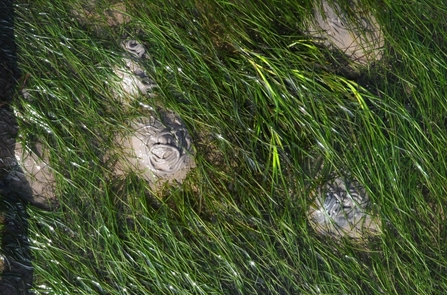
70% of Morecambe Bay's seagrass beds have been lost © Natural England

70% of Morecambe Bay's seagrass beds have been lost © Natural England
We have received a donation of over £141,000 from Ozone and funding from the Environment Agency to restore a vast area of seagrass near Roa Island in the Walney Channel.
Seagrass is the only flowering plant that lives fully underwater, though it can be seen at low tide. It provides a unique and rich habitat for crabs, anemones and fish, and foraging ground for waders and wildfowl. Seagrass beds can also play an important role in tackling climate change. Carbon-rich sediment is stored around the plants and they also draw carbon from the atmosphere and store it in the seabed.
It’s recently been suggested that seagrass beds may be responsible for roughly 10% to18% of the total carbon storage in the ocean1, despite covering less than 0.1% of the global ocean floor2.
However, the UK has lost 90% of all seagrass beds over the last century and in Morecambe Bay, around 70% has been lost. Recent surveys show that around 70ha (127 acres) of seagrass remains in the Walney Channel - that’s around the size of 63 football pitches. But there should be much more!
For several years, we've been carrying out baseline studies of seagrass beds in the region, surveying their size and condition, in collaboration with universities across the North West.
Thanks to this new funding, we can begin restoration trials on the seagrass beds , to bring them back to their former size and health so they can thrive, along with the species that rely on them. Work is ongoing to build a store for seagrass seed at South Walney Nature Reserve and Marine Champions are being trained, to help monitor and protect the seagrass beds and wider marine environment.
Later this year, following more assessments of the area, staff, volunteers and Marine Champions will collect seagrass seed from a healthier site and start a series of different trials, to understand the best method of restoring seagrass in the Walney area.
Amber Gould, Marine Conservation Officer for Cumbria Wildlife Trust said: “We’re hugely grateful to Ozone for this donation, as well as the Environment Agency for their support. This will enable us to understand more about the benefits the seagrass beds are providing to our coastline and the pressures that they’re under. It's also given us the resources we need to help this fantastic ecosystem to recover, and to work with other organisations across the North West to bring about an Irish Sea that’s healthier and wilder in the long term.”
Ozone said: "Ozone is delighted to support Cumbria Wildlife Trust in its efforts to restore seagrass beds as part of our commitment to restoring and improving the natural environment that our sports enjoy exploring."
The Ozone donation for seagrass restoration of £141,964 is given over a three-year period and the EA funding comes from the Championing Coastal Coordination initiative and Defra’s Natural Capital and Ecosystem Assessment (NCEA) programme.
1 Duarte et al 2010
2 Fourqurean et al 2012 for carbon capture https://www.nature.com/articles/ngeo1477